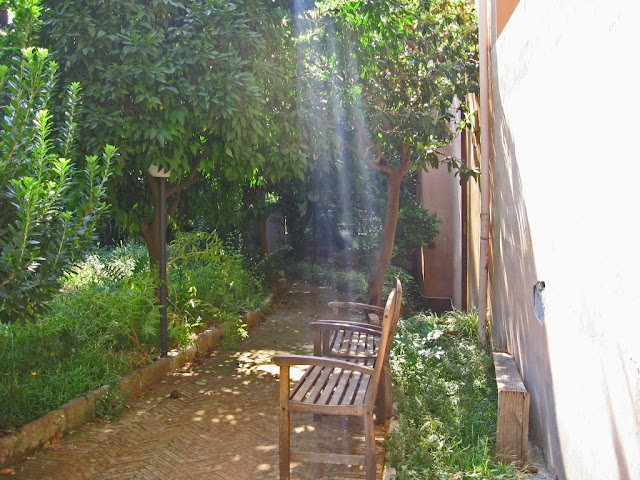The Church and Monastery
of S. Gregorio al Celio in
Rome is a place like no other.
Pope Gregory the Great (540-604 A.D.)
converted his family's patrician villa into a monastery dedicated to Saint
Andrew soon after the death of his father. At one time elected Prefect of the
city of Rome, Gregory was a superb administrator, and on at least one occasion
saved the people of Rome from starvation.
 |
| San Gregorio al Celio |
Reluctantly made Pope, by acclamation, Gregory left the contemplative life in the monastery he had created to turn his attention to administrative affairs and teaching.
He was a great teacher and reformer; many of his pastoral writings and sermons
are preserved.
 |
| Gregory the Great |
He is famous for
having sent a mission to re-evangelize the English in the year 597 A.D.;
forty monks who journeyed there under the leadership of Augustine of
Canterbury. They re-established the Christian faith in the British Isles after
the invasions of the Vikings and other tribes had sounded the death knell of
Roman Britain.
 |
| S. Gregorio al Celio, 1833 - A. Pinelli, Watercolor |
Because
of the success of this mission, the site of Gregory's monastery is today the most important meeting-place for
Anglicans and Roman Catholics, a present symbol of their common roots. When the
Archbishop of Canterbury visits Rome, he and the Pope worship together in a
vespers service held at S. Gregorio.
 |
| Map of the ancient Rome - G. Pinto |
- THE ECUMENICAL GARDEN -
The Ecumenical Garden Project, sponsored by the English-speaking churches of Rome, "Churches
Together in Rome", was initiated by the Reverend Dana English, an
Anglican priest on the staff of All Saints' Anglican Church,
Rome, in September 2012.
The project was conceived as a memorial to
a colleague who died soon after their pre-ordination retreat was held in the
garden in June of 2012.
Realizing that the restoration of the neglected garden, at the edge of which the ordinands had shared their life stories that June, would be an opportunity to help the dwindling and aging community of monks at S. Gregorio, in an ecumenical gesture, Dana gathered interested members of churches in Rome and set to work.
The Prior of the monastery at that time, Peter Hughes, welcomed the project.
 |
| The Ecumenical Garden Project, Beth Blosser - Plan |
An
opportunity for persons from all branches of the Christian Church to come
together, the project began immediately in the autumn of 2012 with volunteers
from Anglican, Methodist, Baptist, and Roman Catholic churches gathering
on successive Saturdays for work sessions to clear the overgrown site.
It was a chance for many people who love gardens, but
who have no garden of their own in the center of the city, and who were glad to
meet and work side by side with new friends from other congregations, to engage
in a common project to benefit the monastic community in this historic
location.
 |
| The Ecumenical Garden site |
The new garden design, created by Beth Blosser, member of All Saints' Anglican Church and a landscape gardener, includes a labyrinth for meditation, a fountain and pergola, paved paths beside the orange trees and a kitchen garden, historically a feature of all monastery gardens.
 |
| The Ecumenical Garden Project, Beth Blosser - Details |
A laurel hedge
borders the alley and Biblical plants adorn all parts of the garden.
There was a delay of more than a year while the application for an
official permit was stalled in the infamous Italian bureaucracy. During this
time fund-raising was slowly taking place and maintenance of the area
continued. The Spring of 2016 has seen hundreds of flowers and trees planted;
all have been taking root. With the generous donation by one of the families of
All Saints’ Anglican Church of four stone and wrought-iron benches, six benches
will be ready to place in the garden by September 1st.
 |
| The Ecumenical Garden site |
The garden, not open to the public, will be a place of repose and contemplation for the monastic community, the dozen theological students who live in the complex during the academic year, guests who stay in the twelve rooms that overlook the garden, students from the nearby St. Stephen's School who have worked in the garden, and others who contribute through funding or manual labor to its restoration. The new Prior, George Nelliyanil, has contributed with much enthusiasm to the project.
 |
| G.B. Nolli - Map of Rome, 1746 |
The formal
Blessing and Dedication of the Garden took place on May 20th, with over 80
ecumenical guests.
Following is the order of service for the ceremony and
list of participants.
Photos of the
great occasion are below!
We
invite all who love gardens and who believe in such an enduring ecumenical
gesture to contribute to our project!
We still need 2-3,000 euro to complete the plantings for the Garden. If you would like to donate to this wonderful, ongoing project, see the details at the top of this website!
With warmest thanks in advance.
If
you would like to contribute funds by direct bank transfer to this project,
details follow:
Banca
Popolare di Sondrio Agenzia 24 Roma
IBAN: IT60
J056 9603 2240 0000 3599 X14
BIC-SWIFT: POSOIT22
Intestazione:
Casa
Generalizia Congregazione Eremiti Camaldolesi,
Piazza
San Gregorio, 1 00184 - Roma
Please
designate clearly that the deposit is for “The Ecumenical Garden Project”
or
contact the Reverend Dana English at dlenglish@aya.yale.edu






